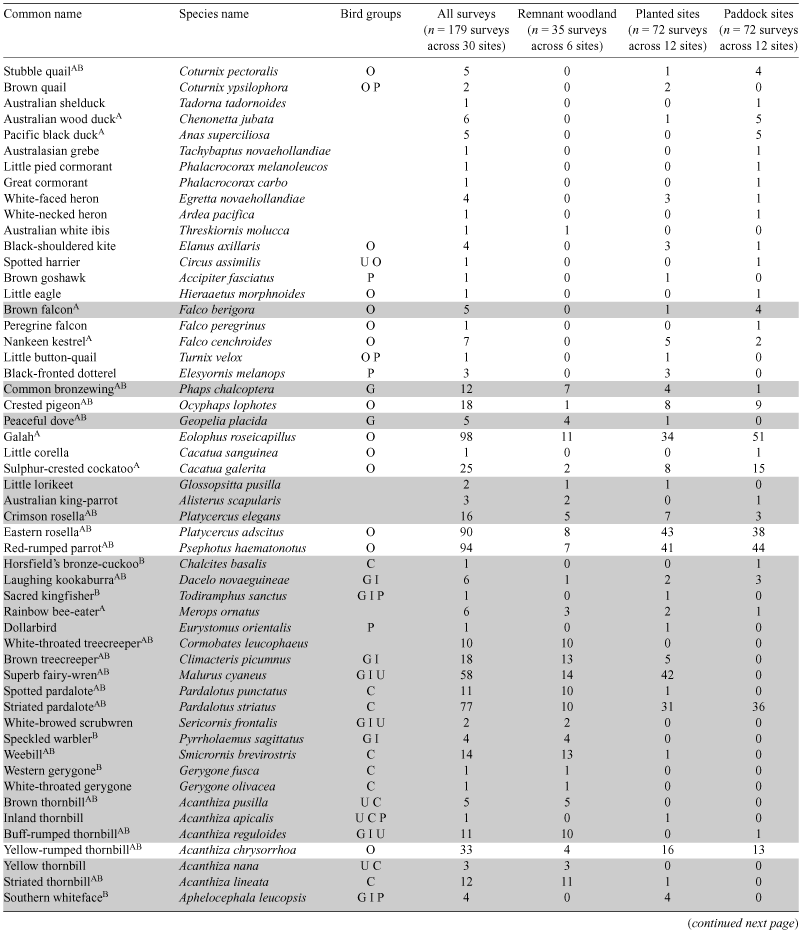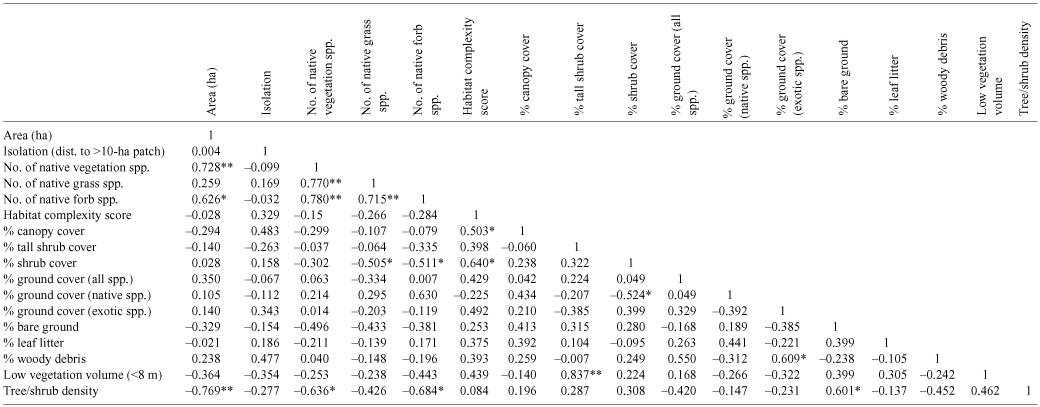Colonisation of native tree and shrub plantings by woodland birds in an agricultural landscape
G. W. Barrett A B , D. Freudenberger A , A. Drew A , J. Stol A , A. O. Nicholls A and E. M. Cawsey AA CSIRO Sustainable Ecosystems, GPO Box 284, Canberra, ACT 2601, Australia.
B Corresponding author. Email: geoff.barrett@csiro.au
Wildlife Research 35(1) 19-32 https://doi.org/10.1071/WR07100
Submitted: 24 July 2007 Accepted: 8 February 2008 Published: 17 March 2008
Abstract
Tree planting has become a cornerstone strategy for natural resource management in agricultural landscapes, yet its contribution as habitat for woodland birds has not been fully investigated. A case study from the Holbrook region in southern New South Wales was used to assess woodland birds in young plantings of native trees and shrubs. Ground-foraging insectivorous woodland birds were under-represented in the plantings, partly due to a lack of native forb diversity (wildflowers) and leaf litter. Of 69 woodland bird species recorded over a three-year period, 48 species (70%) occurred in planted sites, 59 species (86%) occurred in remnant woodland, and 34 species (49%) occurred in adjacent paddock sites. The greater diversity of birds in planted sites relative to paddock sites was mostly due to understorey birds. The proportion of mist-netted birds recaptured was similar in both planted (15%) and remnant woodland (16%) sites, suggesting that individual birds were staying in planted sites. The proportion of woodland birds showing breeding activity (as measured by the presence of a brood patch) was slightly lower in planted sites (24% of all woodland species) than in remnant woodland (29%). Birds such as the superb fairy-wren, red-browed finch and southern whiteface were more likely to occur in planted sites, suggesting that plantings provide unique, transitional-stage habitat within agricultural landscapes. Restoring native forbs, as part of a broader strategy of woodland management, will help to reverse the decline of ground-foraging insectivorous woodland birds in agricultural landscapes.
Acknowledgements
We thank Holbrook Landcare for their support of our research, freely providing access to their farm plantings, established with assistance from the Australian Government Natural Heritage Trust. Holbrook Landcare also generously shared their GIS data and provided staff to assist with site selection. The Earthwatch Institute (scienceprogram@earthwatch.org) provided strong support through the provision of volunteers and an operating budget. Funding was provided by CSIRO Water for a Healthy Country Flagship and by the NSW Environmental Trust. In addition, this project has benefited from internal support from CSIRO Sustainable Ecosystems’ Internal Venture Capital Fund. Tony Arthur, Julian Reid, Suzanne Prober and Yvonne Buckley provided helpful input during the writing and analysis. We also thank Gary Luck and the anonymous referees who provided valuable comments. Finally, we thank all of the volunteers and CSIRO staff (too many to individually mention) for the many hours of field work they have contributed to this research.
Andrén, H. , Angelstam, P. , Lindstrom, E. , and Widen, P. (1985). Differences in predation pressure in relation to habitat fragmentation: an experiment. Oikos 45, 273–277.
| Crossref | GoogleScholarGoogle Scholar |
Barrett, G. W. , Ford, H. A. , and Recher, H. F. (1994). Conservation of woodland birds in a fragmented rural landscape. Pacific Conservation Biology 1(3), 245–256.
Barrett, G. W. , Silcocks, A. F. , Cunningham, R. , Oliver, D. L. , Weston, M. A. , and Baker, J. (2007). Comparison of atlas data to determine the conservation status of bird species in New South Wales, with an emphasis on woodland-dependent species. Australian Zoologist 34, 37–77.
Biddiscombe, E. F. (1985). Bird populations of farm plantations in the Hotham River Valley, WA. Western Australian Naturalist 16, 32–39.
Briggs, S. V. , Seddon, J. A. , and Doyle, S. J. (2007). Structures of bird communities in woodland remnants in central New South Wales, Australia. Australian Journal of Zoology 55, 29–40.
| Crossref | GoogleScholarGoogle Scholar |
Catling, P. C. , and Burt, R. J. (1995). Studies of the ground-dwelling mammals of eucalypt forests in south-eastern New South Wales: the effect of habitat variables on distribution and abundance. Wildlife Research 22, 271–288.
| Crossref | GoogleScholarGoogle Scholar |
Ford, H. A. , Barrett, G. W. , Saunders, D. A. , and Recher, H. F. (2001). Why have birds in the woodlands of southern Australia declined? Biological Conservation 97, 71–88.
| Crossref | GoogleScholarGoogle Scholar |
Fuller, R. J. , Gregory, R. D. , Gibbons, D. W. , Marchant, J. H. , Wilson, J. D. , Baillie, S. R. , and Carter, N. (1995). Population declines and range contractions among lowland farmland birds in Britain. Conservation Biology 9, 1425–1441.
| Crossref | GoogleScholarGoogle Scholar |
Goldney, D. C. , and Bowie, I. J. S. (1990). Some management implications for the conservation of vegetation remnants and associated fauna in the central western region of New South Wales. Proceedings of the Ecological Society of Australia 16, 427–440.
Henderson, H. V. , and Velleman, P. F. (1981). Building multiple regression models interactively. Biometrics 37, 391–411.
| Crossref | GoogleScholarGoogle Scholar |
Mac Nally, R. C. (1990). The roles of floristics and physiognomy in avian community composition. Australian Journal of Ecology 15, 321–327.
| Crossref | GoogleScholarGoogle Scholar |
Prober, S. M. , and Thiele, K. R. (2005). Restoring Australia’s temperate grasslands and grassy woodlands: integrating function and diversity. Ecological Management & Restoration 6, 16–27.
| Crossref | GoogleScholarGoogle Scholar |
Seber, G. A. F. (1965). A note on the multiple recapture census. Biometrika 52, 249–259.
| PubMed |
Taws, N. (2000). The Greening Australia birdwatch project. Canberra Bird Notes 25, 89–94.
Vesk, P. , and Mac Nally, R. (2006). The clock is ticking – revegetation and habitat for birds and arboreal mammals in rural landscapes of southern Australia. Agriculture Ecosystems & Environment 112, 356–366.
| Crossref | GoogleScholarGoogle Scholar |

Watson, J. , Freudenberger, D. , and Paull, D. (2001). An assessment of the focal species approach for conserving birds in variegated landscapes in southeastern Australia. Conservation Biology 15, 1364–1373.
| Crossref | GoogleScholarGoogle Scholar |

Westoby, M. (1989). Opportunistic management for rangelands not at equilibrium. Journal of Range Management 42, 266–274.
| Crossref | GoogleScholarGoogle Scholar |

White, G. C. , and Burnham, K. P. (1999). Program MARK: survival estimation from populations of marked animals. Bird Study 46, 120–138.

Wretenberg, J. , Lindström, A. , Svensson, S. , Thierfelder, T. , and Pärt, T. (2006). Population trends of farmland birds in Sweden and England: similar trends but different patterns of agricultural intensification. Journal of Applied Ecology 43, 1110–1120.
| Crossref | GoogleScholarGoogle Scholar |

Zanette, L. , Doyle, P. , and Trémont, S. (2000). Food shortage in small fragments: evidence from an area-sensitive passerine. Ecology 81, 1654–1666.


|




